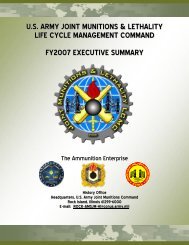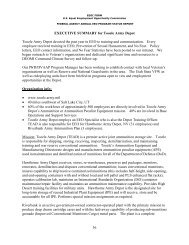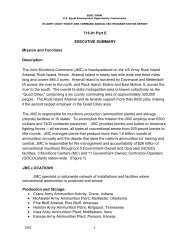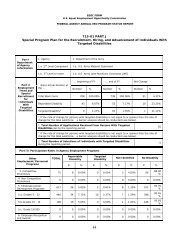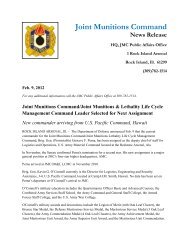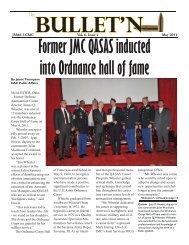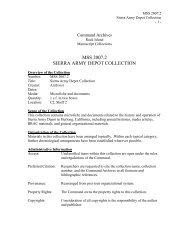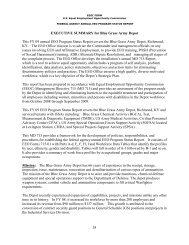History of the Ammunition Industrial Base - JMC - U.S. Army
History of the Ammunition Industrial Base - JMC - U.S. Army
History of the Ammunition Industrial Base - JMC - U.S. Army
Create successful ePaper yourself
Turn your PDF publications into a flip-book with our unique Google optimized e-Paper software.
was a spike in expenditures after a period <strong>of</strong> combat lull. This constant shifting <strong>of</strong> requirements<br />
disconcerted producers. 74<br />
In addition to requirements fluctuations, DoD continued to assume that Vietnam would<br />
be a short war. It took 18-24 months for DoD to realize that <strong>the</strong> short war had gone long. The<br />
stockpile and <strong>the</strong> procurement plan was not designed for this possibility. The Secretary <strong>of</strong><br />
Defense and Bureau <strong>of</strong> <strong>the</strong> Budget continued to plan for a six month war. Not until mid-1967<br />
did <strong>the</strong>y acknowledge that <strong>the</strong> war might be longer term. Until <strong>the</strong>n each contract, budget and<br />
supplemental request was based on <strong>the</strong> requirements for ano<strong>the</strong>r six months <strong>of</strong> combat.<br />
Commercial producers, even those patriotic and committed to supporting <strong>the</strong> Armed Forces,<br />
were not willing to convert from pr<strong>of</strong>itable commercial work to barely pr<strong>of</strong>itable work that<br />
would last only six months. 75<br />
To help alleviate future problems, <strong>the</strong> Besson Board made a number <strong>of</strong> recommendations<br />
for future management <strong>of</strong> <strong>the</strong> ammunition base. While <strong>the</strong>y advocated a mix <strong>of</strong> private and<br />
government plants, <strong>the</strong>y warned:<br />
“Munitions production is a high-risk venture for private industry owing to <strong>the</strong><br />
lack <strong>of</strong> demand for munitions production in peacetime and <strong>the</strong> uncertainties<br />
associated with <strong>the</strong> length <strong>of</strong> <strong>the</strong> war…The facilities and tooling peculiar to<br />
munitions manufacturing, coupled with <strong>the</strong> quantity <strong>of</strong> equipment required to<br />
produce at <strong>the</strong> desired rates, do not lend <strong>the</strong>mselves in total to alternative<br />
commercials use…Pr<strong>of</strong>it motivations <strong>of</strong> private industry does not argue for<br />
retention <strong>of</strong> this equipment in peacetime; hence, <strong>the</strong> production base tends to<br />
evaporate with <strong>the</strong> cessation <strong>of</strong> demand.”<br />
They also warned that despite <strong>the</strong>ir recommendations, military budgets would be<br />
reduced after <strong>the</strong> War. Lack <strong>of</strong> a strategic DoD level plan, dwindling resources, inter<br />
and intra Service disagreements hindered maintaining <strong>the</strong> ammunition base. 76<br />
The Besson Board concluded that <strong>the</strong> ammunition base should be an exception to <strong>the</strong><br />
privatization policy. They determined that maintaining a warm base and a small stockpile was<br />
less expensive and provided more readiness than a large stockpile and a less ready base. The<br />
Board suggested <strong>the</strong> government should own and maintain laid away equipment as it was not<br />
within <strong>the</strong> private, pr<strong>of</strong>it motivated culture to do so. The government also had to retain GOCO<br />
plants in order to assume safety and space requirements. These plans required a continuing<br />
peacetime level <strong>of</strong> funding for <strong>the</strong> ammunition base. Their bottom line was: “The Vietnam<br />
experience emphasizes <strong>the</strong> importance <strong>of</strong> maintaining an adequate production base.” 77<br />
After Vietnam a similar pattern <strong>of</strong> neglect <strong>of</strong> <strong>the</strong> ammunition base continued until <strong>the</strong><br />
early 1980s when modernization programs were implemented. The government attempted to<br />
reduce ammunition expenditures and create efficiencies in a number <strong>of</strong> ways. The most<br />
significant impact between Vietnam and <strong>the</strong> Gulf War was <strong>the</strong> creation <strong>of</strong> <strong>the</strong> Single Manager<br />
for Conventional <strong>Ammunition</strong> (SMCA) in 1977. The <strong>Army</strong> was charged with central<br />
74 Heiser, 109-10, 119-120; Besson Board, 62, 67, 94, 89, 100-01.<br />
75 Heiser, 120; Besson Board, 69, 107.<br />
76 Besson Board, 105-106.<br />
77 Ibid, 105-07, 147.<br />
27



